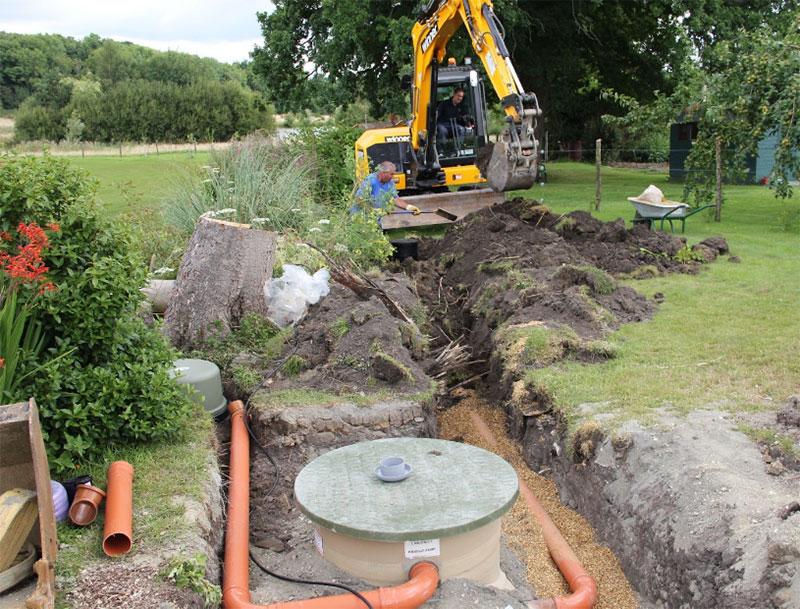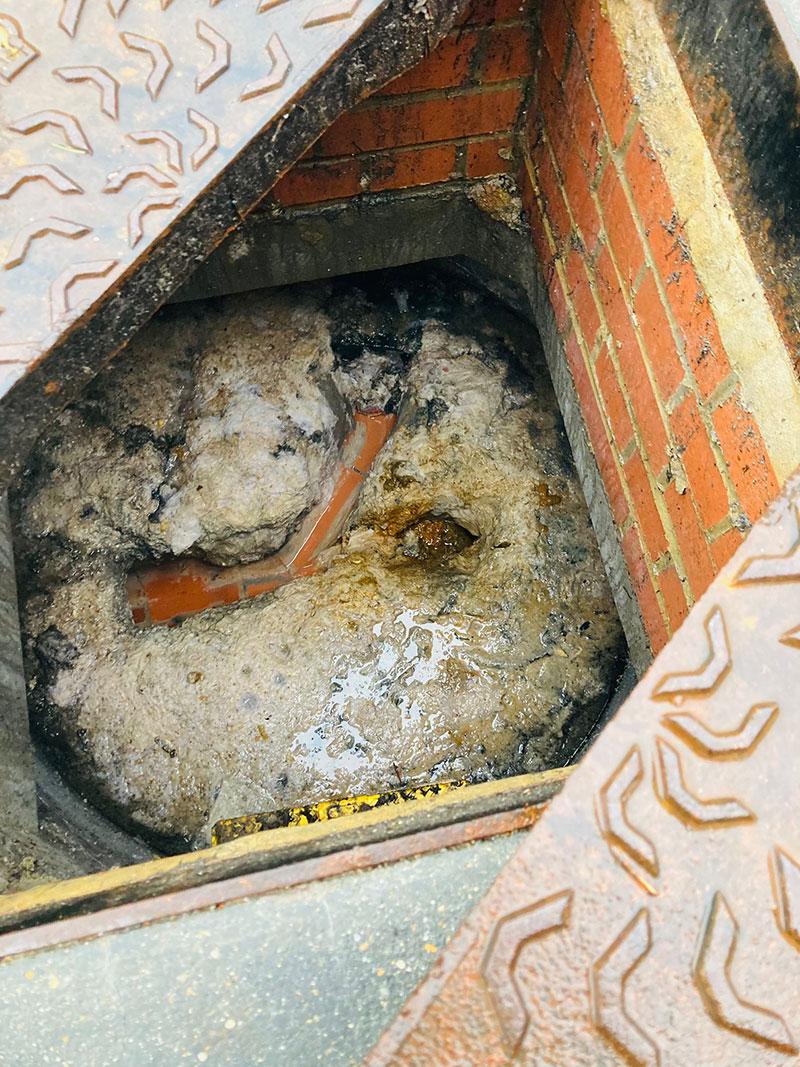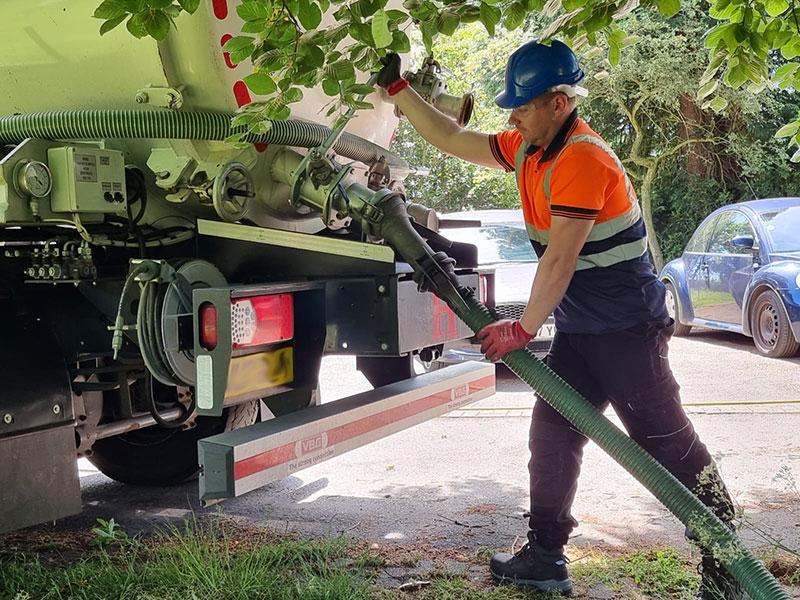Case Study | Considerations for use of domestic septic tanks & sewage treatment plants.
This Case Study is based on a recent job for an upgrade of sewage system.
Observations
Regarding your system, it comprises a square tank, which is typically used as a cesspit when installed in-ground made up of clay. Contractors, who installed the cesspits in the old days, installed them to leak into the surrounding ground, and people progressively used more water as the years went on. Hence, contractors added soakaways beyond the clay into the chalk to cope with the new influx of water.
Your existing soakaways are not currently working. The water and sewage in the tank are at least 200mm high, consequently causing the water and sewage to back up towards the house, allowing the sewage to settle in the pipe rather than flowing freely to the tank.
If we completely removed all the water and sewage from the tank, it would fill back up within two to three weeks, causing the cycle to begin again.

Depending on how the original soakaways were installed and the type of ground, they deteriorated over time. They would last 10 to 20 years. Modern living, washing machines, dishwashers and other kitchen appliances discharging grease and fat into the system have shortened the life of the system. Along with contemporary standards of personal hygiene, including daily bathing for many, increasing the quantity of water through the system has resulted in inadequate separation. The wall in the tank means that this system lacks the capacity required for modern living.
To assess the optimum treatment plant for your property, we require complete information regarding the effluent (which will flow IN) to the treatment plant. You should bear in mind that it is advisable to install a treatment plant capable of servicing the requirements of a full household at peak capacity so that there are no embarrassing limitations when entertaining or when selling the property in the future.
Advisement
Domestic sewage treatment plants.
To keep the population of microorganisms working well, we advise that any cleaning agents such as bleach and proprietary produces are very well diluted before being disposed of down the drains. We also advise against the use of fat, grease, oil or anti-bacterial cleaning products, as these can hurt the microorganisms working in your tank. Installing a larger tank will be necessary and prudent and a grease trap for fat & grease.
As outlined above, fats and grease do not decompose in a septic tank, and therefore it is a good idea to minimise the number of fats and grease entering the system to reduce the risk of possible damage. To this end, we suggest that any excess fats and grease from cooking, once sufficiently cool, should be disposed of with the food waste and not poured down the drains.
Allow capacity when using waste disposal units.

Waste disposal units can cause problems with septic tanks and domestic sewage treatment plants. Waste disposal units grind up the vegetable matter very finely before being discharged into the septic tank. Because the vegetable matter is very fine, it takes longer to separate and sink to the bottom. Therefore, it can float in suspension through to the secondary chamber and possibly into the soakaways as it does not settle to the bottom.
Another factor is that the enzymes that digest the sewage do not tackle cellulose, the chief constituent of vegetable matter. Therefore, this accumulates in a septic tank and/or treatment plant rather than being broken down. This degrades the quality of treatment.
Similarly, if you are considering extending or enlarging the property at some point in the future, installing a treatment plant that could cope with projected numbers rather than the current ones would be advisable. Incidentally, the size of a cesspit under today's standards and regulations is 4,000 gallons. A cesspit does not need any consent to discharge from an environmental agency because they are designed for containment only.
They require emptying every nine to13 weeks depending on usage, family size, etc. A cesspit is typically installed when nothing else is available; in our professional opinion, it can devalue a property by £20,000-£30,000 as they are not the most desirable systems to have.
We have options to solve the problems with a 32 Population non-mains drainage system; based on the preliminary observations made on site, they are varying degrees (minimal and more substantial) of changing the system, and one, involves upgrading the system to a "state of the art" domestic sewage treatment plant, which would treat the sewage to the standards often required by current environmental legislation, discharging virtually clean water into the environment, rather than separated but untreated raw liquid sewage.
Our charge to carry out the above works includes labour, plant and materials. Price is subject to a survey and excludes an electric cable from the house to the tank,
new soakaways or boreholes. Once the survey has been conducted, a meeting will be necessary to discuss the proposed works.
Recommendation: reference to main public sewer
- We will contact the local authorities on your behalf and obtain plans to design a pumping station to pump the waste to the main public sewer or by using gravity alone.
- Using the existing tank
- Supply and install two pumps
- Excavate and install a pumping main up to and into the main public sewage system.
- To eliminate or confirm this possibility, an upfront payment of £50.00 plus VAT needs to be made for us to obtain the necessary plans and conduct a survey to pursue the matter further.
Please note that we have no present information on where the main public sewer is.
Before outlining the options for a domestic sewage treatment plant, we provide further information concerning septic tanks and treatment plants.
Many people new to septic tanks and treatment plants do not realise that the tank should be emptied down periodically (usually annually) to remove the accumulated solids, fats and other non-biodegradable matter. If this does not happen, the solids, etc., begin to fill the first tank, leaving less and less space for the liquid and solids to settle and separate.
If the second tank or treatment plan is working properly, we empty the holding tank not because it's full of water but to retain the gap between the floating crust and the sludge at the bottom. There must be a reasonable gap to allow separation to occur.
Further, the solids etc., can thicken and become encrusted to the sides of the tank and the dip pipes. Then if any significant movement takes place in the tank, the dip pipes can break.

Tank emptying
When having a septic tank or treatment plant emptied, it is important to instruct the tanker company to "De-Sludge" the tank or to ensure that all the solids are removed. In the case of treatment plants or clinker beds, they are immediately partly filled back up with water to allow the space for separation.
We often encounter incidences of septic tanks, especially treatment plants that have been emptied regularly, but only the liquid has been removed, and the solids have accumulated.
This is often because there is a lower charge for liquid removal than solids/sludge. However, as you can appreciate, this is a false economy. We, therefore, advise that explicit instructions are given concerning the removal of solids from the tank.
If proper emptying and maintenance are carried out regularly, a septic tank can function reliably for many years, but if neglected, it will eventually cease to function at all and will be expensive and disruptive to replace.
Additional external factors
Further to the above, if surface water/rainwater can enter the tank, this can cause further problems with separation. If the water enters in a surge, such as during heavy rainfall, or a storm, the incoming water can stir up the first tank, destroying any separation in the primary settlement chamber.
If you suspect that this is a problem, we advise that the drains are checked by CCTV Camera Survey, and any surface water gullies and downpipes are tested to see if they discharge into the foul drainage system.
Option: The treatment plant
We believe that the supply and installation of a Bio+ Treatment plant would provide a solution. We have found the Bio+ series of high specification treatment plants robust and reliable.
These treatment plants have the advantage of very few moving parts, so there is less to go wrong mechanically. They only require emptying down annually rather than every 4 - 6 months, which is much more convenient and cost-effective. Please refer to the enclosed product literature for more information.
Our provisional estimate is subject to the completion of our influent questionnaire and a full site survey, along with obtaining a "Consent to Discharge" from the Environment Agency (if required) and a "Building Control Notice" if necessary, from your local authority, with which we can assist if you wish to proceed. To give you an indication of the likely costs, please see our provisional estimate presented below:-
Provisional Estimate
Subject to the appropriate consent being granted
- To obtain a "Consent to Discharge" if required from the Environment Agency before the commencement of works.
- To obtain a "Building Control Notice" (if required) from your local authority before the commencement of works.
- To supply labour, plant, materials and equipment to install a Treatment Plant (provisionally a Bio+10, for a maximum peak resident population of 8 persons).
- To divert the clean water from the treatment plant to the existing tank used as a holding tank. You can then use the clean water to water the shrubbery. All excess water will be redirected to bore holes or soakaways.
- To leave the garden and grass verge flat, top soiled and tidy. Rolling or seeding is to be done by others.
- Our charge to carry out the above works is subject to a site level survey, test holes, treatment plant size, and agreements.
To supply and install a six population or 12 population treatment plant is in the region of £9,000 to £12,000.
If you think you could benefit from an upgrade to your private sewage system get in touch with us on 0800 181 684

